Related Research Articles
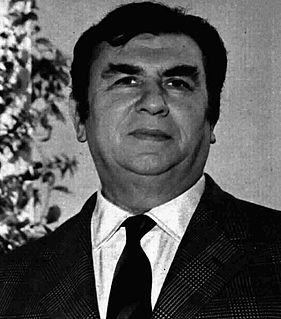
Luigi Cervi, better known as Gino Cervi, was an Italian actor. He was best known for portraying Peppone in a series of comedies based on the character Don Camillo (1952-1965), and police detective Jules Maigret on the television series Le inchieste del commissario Maigret (1964-1972).

Assia Noris was a Russian-Italian film actress.
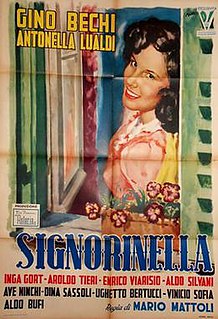
Little Lady is a 1949 Italian comedy film directed by Mario Mattoli and starring Gino Bechi, Antonella Lualdi and Aroldo Tieri. It was shot at the Farnesina Studios in Rome and on location around Introdacqua in L'Aquila. The film's sets were designed by the art director Mario Rappini. It earned around 66 million lira at the box office.

Aroldo Tieri was an Italian actor. He appeared in more than 100 films between 1939 and 1969.

Toto Looks for a Wife is a 1950 Italian comedy film directed by Carlo Ludovico Bragaglia and starring Totò, Ave Ninchi and Marisa Merlini.

Adriana Benetti was an Italian actress.

Strange Inheritance or The Traveller on All Saints' Day is a 1943 French-Italian mystery film directed by Louis Daquin and starring Assia Noris, Jules Berry, Gabrielle Dorziat and Guillaume de Sax. It is an adaptation of the 1941 novel of the same title by Georges Simenon.

The Shortest Day is a 1963 Italian comedy film. It is a parody of the war movie The Longest Day and stars the popular duo Ciccio Ingrassia and Franco Franchi in the leading roles. Dozens of other well-known actors, from both European and American cinema, agreed to appear in the movie in cameo roles for free to avert the bankruptcy of the production company, Titanus.

Aldebaran is a 1935 Italian drama film directed by Alessandro Blasetti and starring Gino Cervi, Evi Maltagliati and Gianfranco Giachetti. The film was a naval melodrama, an attempt by Blasetti to make a more commercial film following the difficulties encountered with the propagandist The Old Guard (1934).

Don Cesare di Bazan is a 1942 Italian historical adventure film directed by Riccardo Freda and starring Gino Cervi, Anneliese Uhlig and Paolo Stoppa. The film is set during the Catalan Revolt of the Seventeenth century. It is based on a play by Philippe Dumanoir and Adolphe d'Ennery. It marked the directoral debut of Freda who went on to be a leading commercial Italian filmmaker.
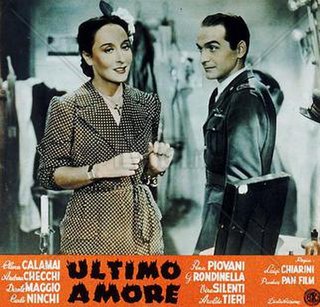
Last Love is a 1947 Italian melodrama film directed by Luigi Chiarini and starring Clara Calamai, Andrea Checchi and Carlo Ninchi. It set during the Second World War with Italy close to defeat and increasingly occupied by German troops. Three Italian soldiers are enjoying some leave when they become involved with an enigmatic female singer!.
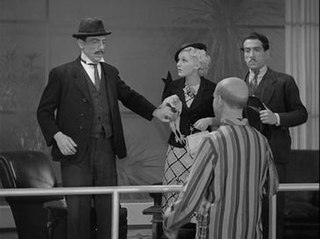
Those Two is a 1935 Italian comedy film directed by Gennaro Righelli and starring Eduardo De Filippo, Peppino De Filippo and Assia Noris. A couple of men struggling to find work both fall in love with the same woman. The story is loosely based on two works by Eduardo De Filippo.

Gli eroi del doppio gioco is a 1962 Italian comedy film directed by Camillo Mastrocinque.
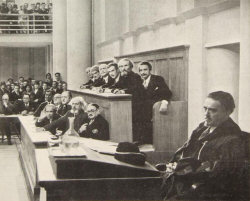
Before the Jury is a 1931 Italian crime film directed by Guido Brignone and starring Marcella Albani, Lia Franca and Carlo Ninchi. It was made at the Cines Studios in Rome. The film is a precursor to the later genre of Giallo films.

Mad About Opera is a 1948 Italian musical comedy film directed by Mario Costa and starring Gino Bechi, Gina Lollobrigida, and Carlo Campanini.
Amina is a 1951 Egyptian film directed by Goffredo Alessandrini and starring Assia Noris, Youssef Wahby and Rushdy Abaza.

Come Back to Sorrento is a 1945 Italian musical comedy film directed by Carlo Ludovico Bragaglia and starring Gino Bechi, Adriana Benetti and Aroldo Tieri. It takes its name from a popular song.

Giallo is a 1933 Italian comedy thriller film directed by Mario Camerini and starring Assia Noris, Sandro Ruffini and Elio Steiner. It is based on the 1928 play The Man Who Changed His Name by Edgar Wallace in which a young wife begins to fear that her husband may in fact be an escaped murderer.
I Want to Live with Letizia is a 1938 Italian "white-telephone" comedy film directed by Camillo Mastrocinque and starring Assia Noris, Gino Cervi and Umberto Melnati.
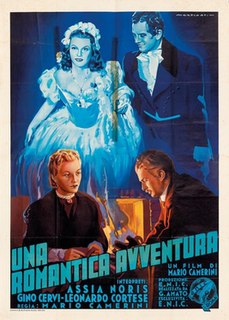
A Romantic Adventure is a 1940 Italian historical drama film directed by Mario Camerini and starring Assia Noris, Gino Cervi and Leonardo Cortese. It is inspired by the 1883 short story The Romantic Adventures Of A Milkmaid by Thomas Hardy. Produced when the two countries were at war, the setting was shifted from the English countryside of the late nineteenth century to Piedmont in the 1830s.
References
- ↑ Moliterno p.227